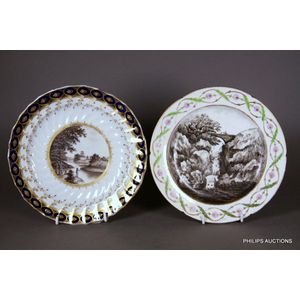Sepia-toned dessert plates with Scottish and floral motifs
You must be a subscriber, and be logged in to view price and dealer details.
Subscribe Now to view actual auction price for this item
When you subscribe, you have the option of setting the currency in which to display prices to $Au, $US, $NZ or Stg.
- Circa - A Latin term meaning 'about', often used in the antique trade to give an approximate date for the piece, usually considered to be five years on either side of the circa year. Thus, circa 1900 means the piece was made about 1900, probably between 1895 and 1905. The expression is sometimes abbreviated to c.1900.
- Gilding - Gilding is a method of ornamentation whereby a thin sheet of gold metal is applied to items made of wood, leather, ceramics, glass and silver for decorative purposes.
For furniture including mirrors, the sheet of gold is usually applied over a coating of gesso. Gesso is a mixture of plaster of Paris and gypsum mixed with water and then applied to the carved wooden frames of mirrors and picture frames as a base for applying the gold leaf. After numerous coats of gesso have been applied, allowed to dry and then sanded a coat of "bole", a usually red coloured mixture of clay and glue is brushed on and allowed to dry, after which the gold leaf is applied. Over time parts of the gilding will rub off so the base colour can be seen. In water gilding, this was generally a blue colour, while in oil gilding, the under layer was often yellow. In Victorian times, gilders frequently used red as a pigment beneath the gold leaf.
Metal was often gilded by a process known as fire gilding. Gold mixed with mercury was applied and heated, causing the mercury to evaporate, the long-term effect of which was to kill or disable the craftsman or woman from mercury poisoning. The pursuit of beauty has claimed many victims, not the least of which were the artists who made those pieces so highly sought after today.
This item has been included into following indexes:
Visually similar items

Two Derby named view plates decorated by Zachariah Boreman and Thomas 'Jockey' Hill, circa 1790-1792, with rare blue mark to one, a plate centred with a finely painted roundel, 'Near Breadshall Derbyshire', pattern 18, in the manner of Boreman, with a fine

Two Copeland felspar handpainted porcelain plates, decorated with floral centre and gilded edges, diameter 25 cm

Four saucers by Chamberlain Worcester, Pinxton, circa 1780s-1810, two items unmarked, a Chamberlain Worcester shanked saucer pattern N.66; a Worcester fluted bowl with a fancy bird, crescent mark underside and an unmarked Worcester saucer; a Pinxton saucer

Two Japan pattern plates Fb&B Worcester, and other, circa 1810, a Flight Barr & Barr Worcester 'Rock and Fence' pattern plate in typical colours with touches of pink and apple green within a gold and blue reserved border with gadroons; and a walled garden
